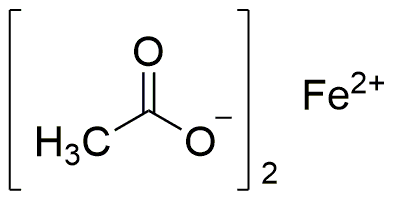Iron(II) acetate is widely utilized in research focused on:
- Analytical Chemistry: It serves as a reagent in various analytical techniques, helping to determine the presence of other compounds in samples.
- Organic Synthesis: This compound is used as a catalyst in organic reactions, particularly in the synthesis of complex organic molecules, enhancing reaction rates and yields.
- Biochemistry: Iron(II) acetate plays a role in biochemical studies, particularly in enzyme assays and metabolic pathways, providing insights into iron's biological functions.
- Material Science: It is applied in the production of iron-based materials, contributing to the development of coatings and pigments that require iron for their properties.
- Environmental Science: The compound is used in studies related to soil chemistry and remediation, helping to understand iron's role in nutrient cycling and pollutant degradation.
General Information
Properties
Safety and Regulations
Applications
Iron(II) acetate is widely utilized in research focused on:
- Analytical Chemistry: It serves as a reagent in various analytical techniques, helping to determine the presence of other compounds in samples.
- Organic Synthesis: This compound is used as a catalyst in organic reactions, particularly in the synthesis of complex organic molecules, enhancing reaction rates and yields.
- Biochemistry: Iron(II) acetate plays a role in biochemical studies, particularly in enzyme assays and metabolic pathways, providing insights into iron's biological functions.
- Material Science: It is applied in the production of iron-based materials, contributing to the development of coatings and pigments that require iron for their properties.
- Environmental Science: The compound is used in studies related to soil chemistry and remediation, helping to understand iron's role in nutrient cycling and pollutant degradation.
Documents
Safety Data Sheets (SDS)
The SDS provides comprehensive safety information on handling, storage, and disposal of the product.
Product Specification (PS)
The PS provides a comprehensive breakdown of the product’s properties, including chemical composition, physical state, purity, and storage requirements. It also details acceptable quality ranges and the product's intended applications.
Certificates of Analysis (COA)
Search for Certificates of Analysis (COA) by entering the products Lot Number. Lot and Batch Numbers can be found on a product’s label following the words ‘Lot’ or ‘Batch’.
*Catalog Number
*Lot Number
Certificates Of Origin (COO)
This COO confirms the country where the product was manufactured, and also details the materials and components used in it and whether it is derived from natural, synthetic, or other specific sources. This certificate may be required for customs, trade, and regulatory compliance.
*Catalog Number
*Lot Number
Safety Data Sheets (SDS)
The SDS provides comprehensive safety information on handling, storage, and disposal of the product.
DownloadProduct Specification (PS)
The PS provides a comprehensive breakdown of the product’s properties, including chemical composition, physical state, purity, and storage requirements. It also details acceptable quality ranges and the product's intended applications.
DownloadCertificates of Analysis (COA)
Search for Certificates of Analysis (COA) by entering the products Lot Number. Lot and Batch Numbers can be found on a product’s label following the words ‘Lot’ or ‘Batch’.
*Catalog Number
*Lot Number
Certificates Of Origin (COO)
This COO confirms the country where the product was manufactured, and also details the materials and components used in it and whether it is derived from natural, synthetic, or other specific sources. This certificate may be required for customs, trade, and regulatory compliance.


